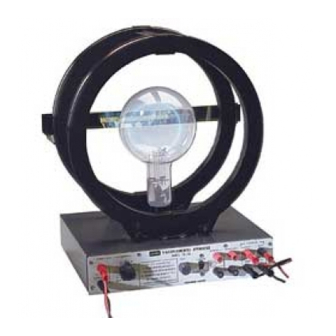
Advertisement
Includes
Instruction Manual and
Teacher's Notes
and
Experiment Guide for
Typical
Experiment Results
the PASCO scientific
Model SE-9638
®
e/m APPARATUS
10101 Foothills Blvd. • Roseville, CA 95678-9011 USA
Phone (916) 786-3800 • FAX (916) 786-8905 • web: www.pasco.com
012-03471E
better
ways to
teach science
Advertisement
Table of Contents

Subscribe to Our Youtube Channel
Summary of Contents for PASCO SE-9638
- Page 1 012-03471E Teacher’s Notes Experiment Guide for Typical Experiment Results the PASCO scientific Model SE-9638 e/m APPARATUS better ® 10101 Foothills Blvd. • Roseville, CA 95678-9011 USA ways to Phone (916) 786-3800 • FAX (916) 786-8905 • web: www.pasco.com teach science...
- Page 2 e/m Apparatus 012-03471E Discard This Page ®...
-
Page 3: Table Of Contents
012-03471D e/m Apparatus Table of Contents Section Page Copyright, Warranty, and Equipment Return ........... ii Introduction ...................... 1 Equipment ......................1 Operation Measuring e/m ..................2 Analysis of e/m Measurement .............. 3 Deflections of Electrons in an Electric Field ........4 Two Simple Demonstrations .............. - Page 4 PASCO scientific. year from the date of shipment to the customer. PASCO Equipment Return Should this product have to be returned to PASCO scientific,...
- Page 5 Type of Computer (Make, Model, Speed). To Reach PASCO Type of external Cables/Peripherals. • If your problem is with the PASCO apparatus, note: For Technical Support call us at 1-800-772-8700 (toll- free within the U.S.) or (916) 786-3800. Title and Model number (usually listed on the label).
-
Page 6: Introduction
012-03471E e/m Apparatus Introduction The PASCO Model SE-9638 e/m Apparatus provides a simple method for measuring e/m, the charge to mass ratio Helmholtz coils of the electron. The method is similar to that used by J.J. Thomson in 1897. A beam of electrons is accelerated... -
Page 7: Operation
Ammeter with 0-2 A range to measure current in without parallax error. Helmholtz coils (such as the PASCO Model SB- 9624 Multimeter) Additional Equipment Needed— Voltmeter with 0-300 V range to measure accelerat-... -
Page 8: Analysis Of E/M Measurement
012-03471E e/m Apparatus Toggle Switch: Current adjust knob Up for e/m experiment, for Helmholtz coils Down when using deflection plates. Focus knob Upper Lower Ammeter Voltmeter Power Supply (0-2 A) (0-300 (Heater VDC) 6.3 VDC or VAC) Power Supply (Helmholtz Coils 6-9 VDC, Power Supply ripple <... -
Page 9: Deflections Of Electrons In An Electric Field
e/m Apparatus 012-03471E 2. Apply the 6.3 (VDC or VAC), or voltage noted on tube, where: to the HEATER and 150-300 VDC to the ELEC- V = the accelerating potential TRODES of the ELECTRON GUN (the accelerating a = the radius of the Helmholtz coils potential). -
Page 10: Diagram Of Connections
Lower Deflection e/m Tube Plates pin 11 pin 10 Anode pin 6 Grid Cathode Focus Adjust pin 2 Variable 150-300 VDC Heater Resistor pin 1 pin 12 Heater Voltage Power Supply Diagram of Connections for the SE-9638 e/m Apparatus ®... -
Page 11: Improving Experimental Results
e/m Apparatus 012-03471E Improving Experimental Results Measurement of e/m Notes 1) The greatest source of error in this experiment is the velocity of the electrons. First, the non-uniformity of the accelerating field caused by the hole in the anode causes the velocity of the electrons to be slightly less than their theoretical value.
















Need help?
Do you have a question about the SE-9638 and is the answer not in the manual?
Questions and answers